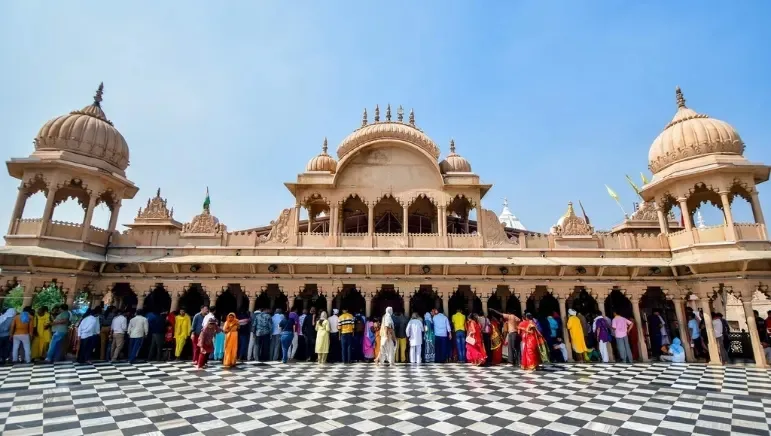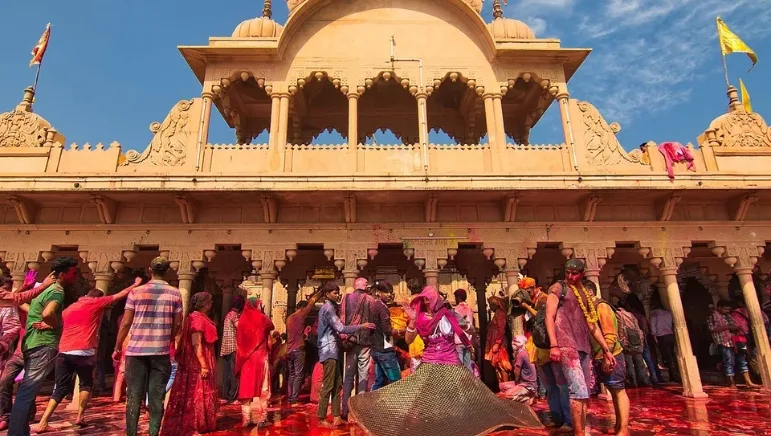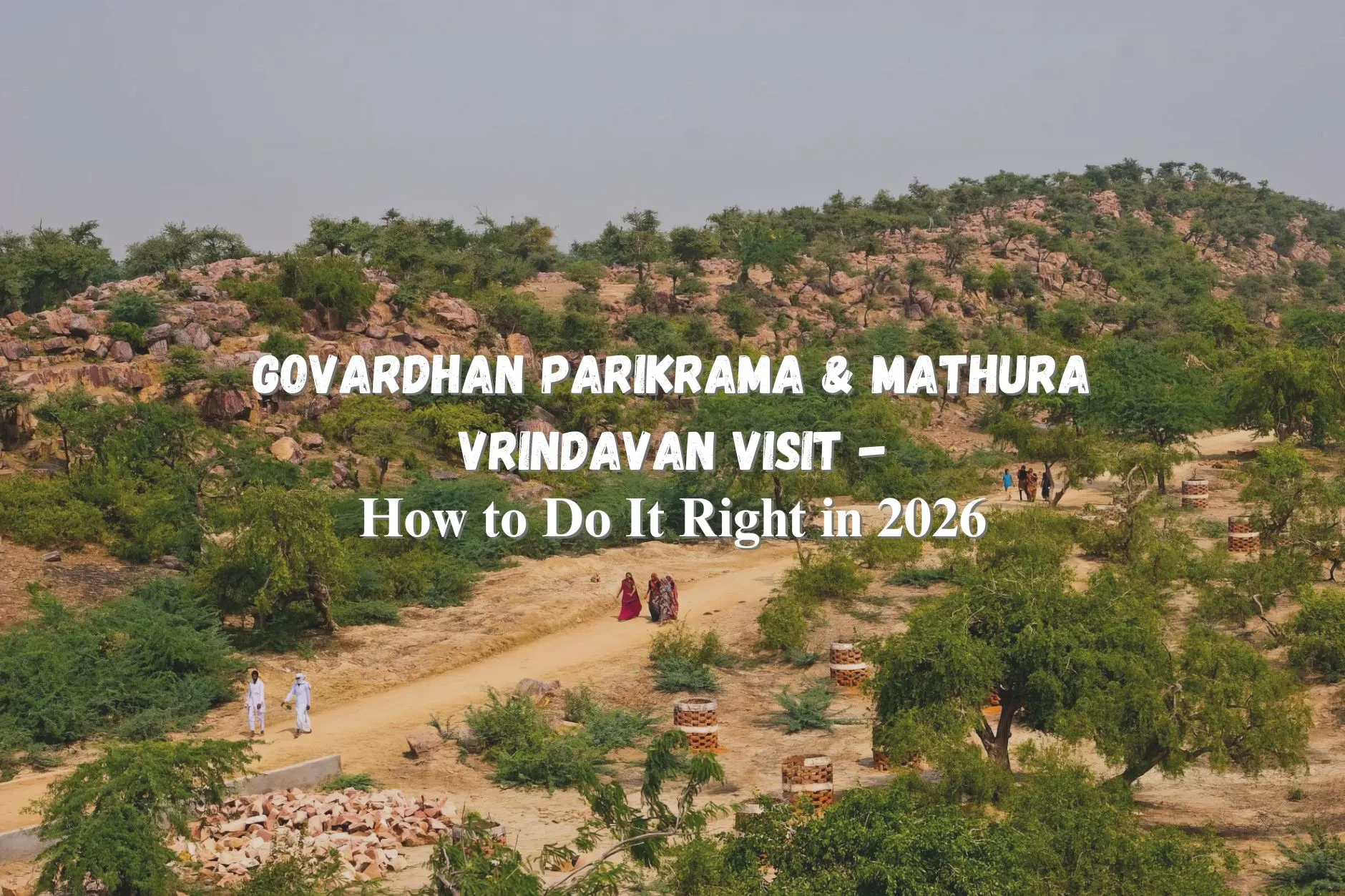Nestled in the heart of the Braj region in Uttar Pradesh, Barsana Radha Rani Temple stands as a beacon of eternal love and devotion, drawing pilgrims and spiritual seekers from across the globe.
Perched on Brahmagiri Hill, this sacred site is not just a temple but a living embodiment of the divine romance between Radha and Krishna, central figures in Hindu mythology.
Known locally as “Shri Ji Temple,” it honours Radha Rani, regarded as the supreme embodiment of devotion, whose grace is believed to infuse every stone and pathway here.
Visitors ascend about 200 steps to reach the main sanctum, where the air is filled with the fragrance of jasmine and distant echoes of devotional songs, transporting all to an era of playful leelas and profound spiritual ecstasy.
Barsana, a quaint town in Uttar Pradesh’s Mathura district, is synonymous with Radha’s childhood and her unbreakable bond with Krishna.
Unlike the more opulent temples of nearby Vrindavan, Barsana exudes a rustic charm, where the hills themselves whisper tales of yore.
The temple’s allure lies in its simplicity—adorned not with gold but with the colours of Holi, celebrating the vibrant love that defies all boundaries.
For devotees, a visit here is more than a pilgrimage; it’s a soul-stirring journey into the essence of bhakti, where Radha’s compassionate gaze promises liberation from worldly woes.
In this comprehensive guide, we’ll delve deep into the temple’s rich history, unravel the mystical aarti timings that mark the day’s divine rhythm, and outline the most seamless ways to reach this heavenly abode.
Whether you’re a first-time visitor or a seasoned pilgrim, Barsana offers layers of discovery that linger long after your departure.
As we explore, remember the words of a timeless devotee: “Radha and Krishna are one but have assumed two forms for the purpose of performing loving pastimes.” This unity of souls is the very heartbeat of Barsana.
The Timeless History of Barsana Radha Rani Temple
The origins of Barsana Radha Rani Temple date back thousands of years, according to ancient scriptures and Braj tradition.
Barsana is described as the birthplace of Radha Rani, daughter of King Vrishabhanu and Queen Kirti, who was born near the Yamuna River.
Legends say Radha’s presence brought light and joy to the area, leading Krishna to visit often. The temple is surrounded by four hills named after Radha’s close friends: Lalita, Vishakha, Chitra, and Indulekha.
Historical records trace the temple’s formal establishment to King Vajranabh, the great-grandson of Lord Krishna and grandson of Pradyumna. Around 5,000 years ago, in a bid to preserve the Braj bhoomi’s sanctity post-Krishna’s departure to Dwarka, Vajranabh constructed the initial shrine on Brahmagiri Hill.
This hill, revered as the site of Radha’s palace, was believed to be where she held court with her gopis, weaving garlands of wildflowers for her beloved Kanha.
The king’s devotion led to the installation of Radha’s murti (idol), crafted from rare black stone sourced from the Govardhan Hill, symbolising her unyielding love that mirrors Krishna’s flute.
Over centuries, the temple survived invasions and was expanded during the medieval era by Rajput patrons. The current temple, mixing Nagara and local Braj architecture, was rebuilt in 1675 AD by Bundela king Veer Singh Dev after he reportedly had a vision of Radha instructing him to restore her place. Additions included the toran (entrance arch) and a mandapa (pillared hall) for gatherings.
The temple’s history is also intertwined with the Bhakti movement of the 16th century, when saints like Surdas and Mirabai immortalised Barsana in their verses.
Surdas, the blind poet-saint, composed poignant padavalis describing Radha’s Barsana as “the queen of all lands, where love blooms eternal.”
These literary tributes not only preserved the temple’s legacy but also fueled its resurgence as a pilgrimage hub. Today, the temple complex spans several acres, encompassing sub-shrines like the Maan Mandir (temple of Radha’s sulking) and the Rangili Gali (street of colours), where Holi celebrations reach feverish pitches.
What makes Barsana’s history truly profound is its resilience. Despite Mughal-era suppressions, the locals covertly maintained rituals, passing down oral traditions through generations of gopis and sakhis.
Archaeological findings, including ancient inscriptions and terracotta artefacts unearthed in the 20th century, corroborate these tales, revealing layers of devotion etched into the very soil.
As one ascends the hill, pausing at the Chaurasi Khamba (84 pillars) en route, visitors can’t help but feel the weight of millennia—the footsteps of Krishna mingling with those of countless devotees.
In essence, the history of Barsana Radha Rani Temple is a tapestry of divine intervention, royal patronage, and unwavering faith.
It stands as a testament to how a simple village girl ascended to the status of the divine feminine, her temple a sanctuary where history and mythology dissolve into one.
“Srimati Radharani is the topmost devotee of Krishna, and Her service attitude is the highest form of devotion. Even Krishna cannot comprehend the depth of her love.”
This quote encapsulates why Barsana remains an eternal magnet for souls seeking that profound connection.



Mythological Significance: The Eternal Leela of Radha-Krishna
Besides its historical background, Barsana Temple is important in mythology as the central location for Radha and Krishna’s legends. The Brahma Vaivarta Purana describes Barsana as Radha’s kingdom, where Krishna often visited her.
Brahmagiri Hill is considered the place where Radha first opened her eyes, earning her the name “Radha,” meaning “to illuminate.”
One popular legend is the “Maan Leela,” performed every year during Holi at the temple’s Maan Mandir. In this enactment, Radha pretends to be upset with Krishna, prompting him and his friends to approach her with colours, only to be playfully chased away by Radha’s companions using sticks. This event is still celebrated as part of Barsana’s Holi tradition, emphasising Radha’s special role.
The temple’s sanctity is amplified by its association with the Ashtasakhi (eight principal friends of Radha), whose hills encircle Barsana like protective sentinels.
Lalita Kund, a serene pond nearby, is said to be where Radha bathed, her laughter echoing through the valleys as Krishna hid behind lotuses to catch a glimpse.
These sites, dotted around the temple, form a sacred parikrama route, allowing pilgrims to trace the footsteps of the divine duo.
Mythologically, Radha transcends her role as Krishna’s consort; she is Prakriti to his Purusha, the devotee’s gateway to the divine.
The temple’s central murti, depicting Radha in a regal posture with a serene smile, invites darshan that stirs the heart. Devotees believe that offering prayers here purifies the soul, granting the boon of selfless love.
“True love is not just seen in the eyes but felt in the soul—just like Radha and Krishna.”
This sentiment resonates deeply in Barsana, where every archway and alcove narrates a fragment of their cosmic romance.
The temple celebrates festivals such as Radha Ashtami, marking Radha’s birthday in the Bhadrapada month, and Phool Bangla, the flower festival when the deity is decorated with flowers.
These festivals attract devotees, who come to witness floral decorations and reenact scenes connected to Radha and Krishna as described in the scriptures.
Aarti Timings: Syncing Your Soul with the Divine Rhythm
No visit to Barsana Radha Rani Temple is complete without participating in the aartis—those mesmerising rituals where lamps flicker like stars, and the air vibrates with the power of collective devotion.
The aartis follow the traditional sandhya kalas (twilight divisions), aligning the day’s spiritual flow with Radha’s eternal grace.
These timings, rooted in ancient Vedic practices, vary slightly with seasons to accommodate the sun’s arc, ensuring devotees can immerse themselves regardless of the weather.
The temple’s daily schedule is a symphony of offerings: from the pre-dawn awakening to the serene goodnight lullaby. Mangla Aarti heralds the dawn, with priests gently rousing the deity amid soft conch blows and incense curls.
Shringar Aarti follows, as Radha is bedecked in jewels and silks, her beauty evoking Krishna’s flute melodies. Rajbhog marks the midday feast, a time of abundance symbolising the soul’s nourishment.
As evening descends, Sandhya Aarti bathes the hill in golden hues, while Shayan Aarti tucks the divine into restful slumber.
To help plan your darshan, here’s a comprehensive table of the aarti timings at Barsana Radha Rani Temple. Note that these are standard for most of the year; during winters (November to February), timings shift by about an hour later to align with shorter days. Always confirm on-site for festivals, when special aartis extend the schedule.
| Mangla Aarti | 5:00 AM | 6:00 AM | Midday feast symbolizes divine sustenance and gratitude. |
| Shringar Aarti | 7:30 AM | 8:30 AM | Evening revival: prepares for twilight devotion. |
| Rajbhog Aarti | 1:00 PM | 1:30 PM | Midday feast; symbolizes divine sustenance and gratitude. |
| Uthapan Aarti | 4:30 PM | 4:30 PM | Evening revival; prepares for twilight devotion. |
| Sandhya Aarti | 7:00 PM | 7:30 PM | Sunset homage; lamps illuminate the sanctum in a blaze of bhakti. |
| Shayan Aarti | 9:00 PM | 10:00 PM | Bedtime lullaby; conch shells signal peaceful closure. |
The temple remains open from 5:00 AM to 1:30 PM in the mornings and 4:30 PM to 9:00 PM in the evenings, allowing ample time for parikrama and private prayers.
Arriving early for Mangla Aarti is magical—the hill is shrouded in mist, and the first rays kiss Radha’s idol, creating an otherworldly glow.
During peak seasons like Holi or Janmashtami, aartis draw thousands, turning the mandapa into a sea of swaying lamps.
Pro tip: Carry a small diya (lamp) to offer during Sandhya—it’s a simple act that deepens your bond with the divine feminine.
Participating in these aartis isn’t just ritualistic; it’s transformative. The rhythmic clanging of bells and the priest’s resonant invocations dissolve ego, leaving only pure surrender.
As you join the chorus of “Jai Shri Radhe,” feel the temple’s energy weave through you, echoing the leelas that birthed this sacred space.
Best Way to Reach Barsana Radha Rani Temple: Seamless Journeys from Mathura
Embarking on a pilgrimage to Barsana begins with thoughtful planning, especially when starting from the gateway of Braj—Mathura. The temple is conveniently located about 45-50 kilometres northeast of Mathura, making it an ideal day trip or extension to your Vrindavan itinerary.
The journey itself is scenic, winding through mustard fields and Yamuna-kissed villages, offering glimpses of rural India’s timeless beauty.
With options ranging from public transport to personalised rides, reaching Barsana is effortless, ensuring your focus remains on spiritual immersion.
By far, the most comfortable and flexible mode is hiring a dedicated taxi service from Mathura. For a hassle-free experience, consider Mathura Taxi Service—your trusted partner for Braj explorations.
With a fleet of well-maintained vehicles, from sedans to spacious SUVs, they specialise in temple circuits, including direct drops to Barsana’s foothills.
Contact them at mathurataxiservice@gmail.com or dial +91 9634616363 to book in advance. Their drivers, well-versed in local lore, often share en route anecdotes about Radha’s leelas, turning the 1-1.5 hour drive into a narrative delight.
Fares are reasonable, starting from economical packages that cover fuel, tolls, and wait times at the temple—perfect for those climbing the 200 steps unburdened.
If budget is a concern, Uttar Pradesh State Road Transport Corporation (UPSRTC) buses ply frequently from Mathura’s New Bus Stand.
These air-conditioned and non-AC options depart every 15-20 minutes, covering the distance in about 1.5 hours for a nominal fee.
Alight at Barsana Bus Stand, from where auto-rickshaws or e-rickshaws ferry you the remaining 2 kilometres uphill for a small charge.
However, for families or groups carrying offerings, buses can feel crowded, especially during festivals.
For the adventurous, two-wheelers like rented scooters are available in Mathura, offering a breezy 1-hour ride via NH19 and local roads.
The route is straightforward: Head east from Mathura towards Govardhan, then veer right at the Barsana signage. GPS apps work reliably here, but do factor in narrow lanes near the hills.
Train enthusiasts note that Mathura Junction is the nearest railhead, with taxis readily available for the onward leg.
No matter your choice, aim to start early—post-sunrise—to beat the midday heat and secure prime darshan spots. Mathura Taxi Service stands out for its reliability; their 24/7 helpline ensures last-minute bookings, and eco-friendly vehicles align with the temple’s serene ethos.
One pilgrim shared, “The drive with Mathura Taxi Service felt like part of the leela—smooth roads, soulful stops, and a heart full of Radha’s grace.” Whether solo or in a convoy, this journey sets the tone for Barsana’s embrace.
Safety note: November to March is ideal for visits, with mild weather enhancing the hill climb. Carry water, wear comfortable shoes, and respect local customs by covering heads in the sanctum.
Essential Visiting Tips for an Enriching Darshan
To maximise your Barsana sojourn, a few insider tips go a long way. Dress modestly—women in salwar kuits or sarees, men in kurtas—to blend with the devotional vibe.
Offerings like flowers, sweets (peda is a favourite), and new clothes for Radha are warmly received at the hundi. For vegetarians, the temple’s prasad langar offers simple, sattvic meals; savour the kheer blessed by Shri Ji herself.
Explore beyond the central temple: The nearby Sankari Khor (Radha’s swing) and Bhanu Ghaat on the Yamuna are must-visits for a full parikrama.
If travelling with Mathura Taxi Service, request a guided halt—their packages often include these gems. Hydrate frequently during the ascent, and if mobility is an issue, palanquins are available for a fee.
Festivals amplify the magic—Holi in Barsana is UNESCO-recognised for its Lathmar Holi, where colours fly in Radha’s honour.
Book stays in nearby ashrams for an authentic feel, and remember: The true souvenir is the peace that Radha bestows.
Conclusion: A Call to Radha’s Abode
Barsana Radha Rani Temple isn’t merely a destination; it’s a divine invitation to awaken the lover within. From its ancient history carved in stone to the aartis that light the soul, and the easy paths that lead you there, every element conspires to deepen your bhakti.
As you leave, carry her quote in your heart: “Let the divine love of Radha Krishna inspire your life.” Plan your visit today—dial Mathura Taxi Service at +91 9634616363 or email mathurataxiservice@gmail.com for that perfect ride to eternity. Jai Shri Radhe!
FAQs
1. Where is Barsana Radha Rani Temple located?
Barsana Radha Rani Temple, also known as Shri Ladli ji Temple, is located on Bhanugarh Hill in Barsana, around 45 km from Mathura and 20 km from Govardhan.
2. What is the history of Radha Rani Temple in Barsana?
The temple is believed to be built at the birthplace of Goddess Radha. The present structure dates back several centuries and is connected to the Gaudiya Vaishnava tradition. It is known for its divine ambience, ancient stone architecture, and sacred hilltop location.
3. What are the aarti timings at Radha Rani Temple?
Aarti timings vary by season, but the main aarti generally happens in the morning around 5:30 AM – 6:00 AM and in the evening around 6:30 PM – 7:00 PM. During festivals, additional aartis and ceremonies take place.
4. How to reach Barsana Radha Rani Temple from Mathura?
You can reach Barsana by taxi, auto, or state bus. Taxis are the fastest and most comfortable option, taking around 1 to 1.5 hours depending on traffic.
5. How challenging is the climb to the temple?
The temple is situated at the top of a hill. You need to climb a series of steps (approximately 200–250). However, railings and resting spots are available, making the climb manageable for most visitors.
6. What is the best time to visit Barsana Radha Rani Temple?
The ideal months are October to March when the weather is pleasant. For spiritual travellers, special days like Radhashtami, Lathmar Holi, and Sharad Purnima are considered highly auspicious.
7. Are there any special rituals or events at the temple?
Yes, the temple is famous for Lathmar Holi, Radhashtami celebrations, daily aarti, bhajan kirtans, and special offerings during the Kartik month.
8. What are the darshan timings of the temple?
The temple usually opens early morning around 4:30 AM – 5:00 AM and closes after evening aarti around 8:30 PM – 9:00 PM. Timings may vary during summer and winter.
9. Is parking available near the temple?
Yes, parking is available near the base of the hill. From the parking spot, you need to walk uphill using the temple steps.
10. Can elderly people visit Barsana Radha Rani Temple comfortably?
Yes, many elderly devotees visit daily. Though the climb involves stairs, people usually take small breaks. Some local helpers offer support to elderly visitors if needed.





Leave a Reply